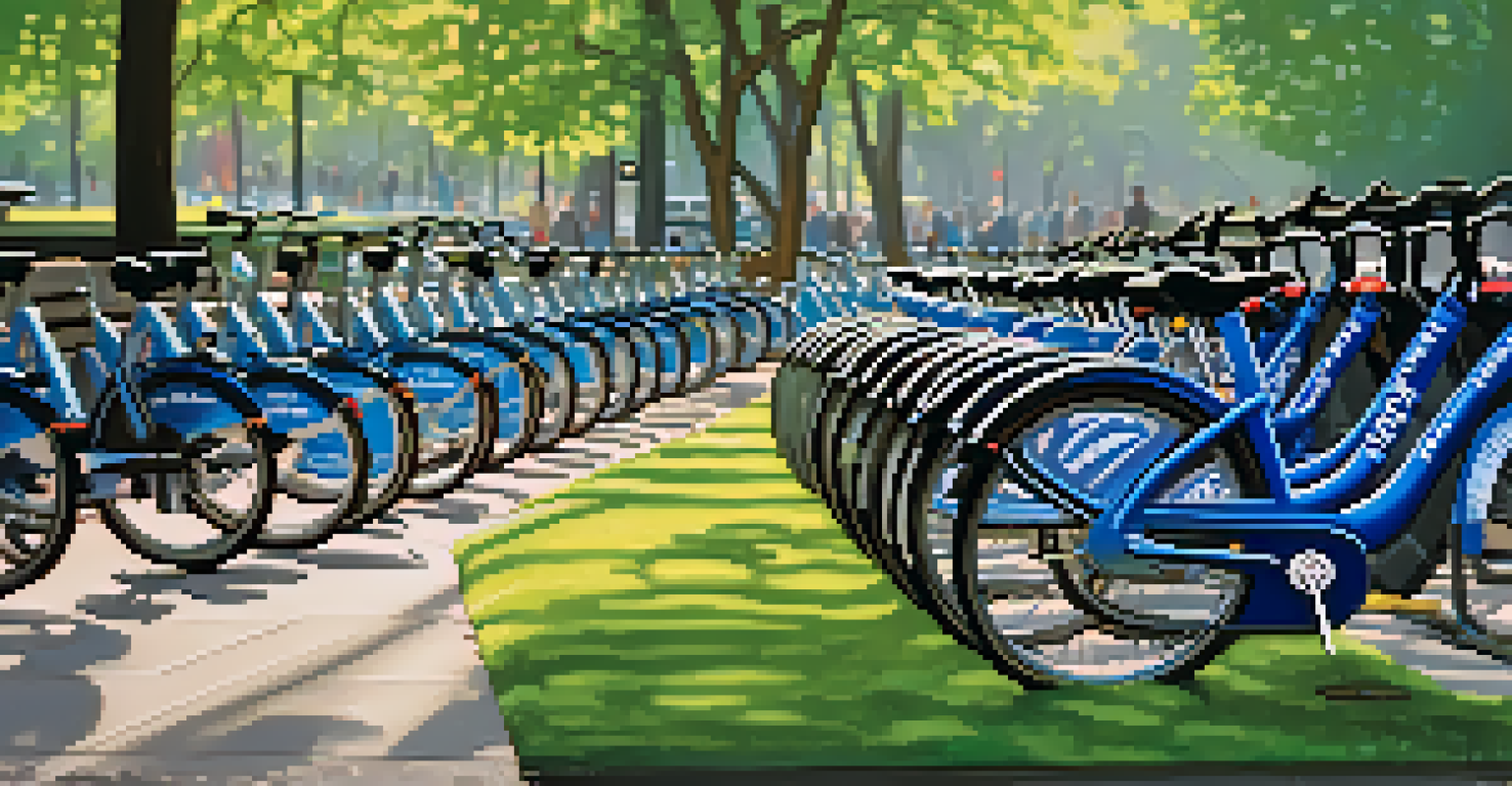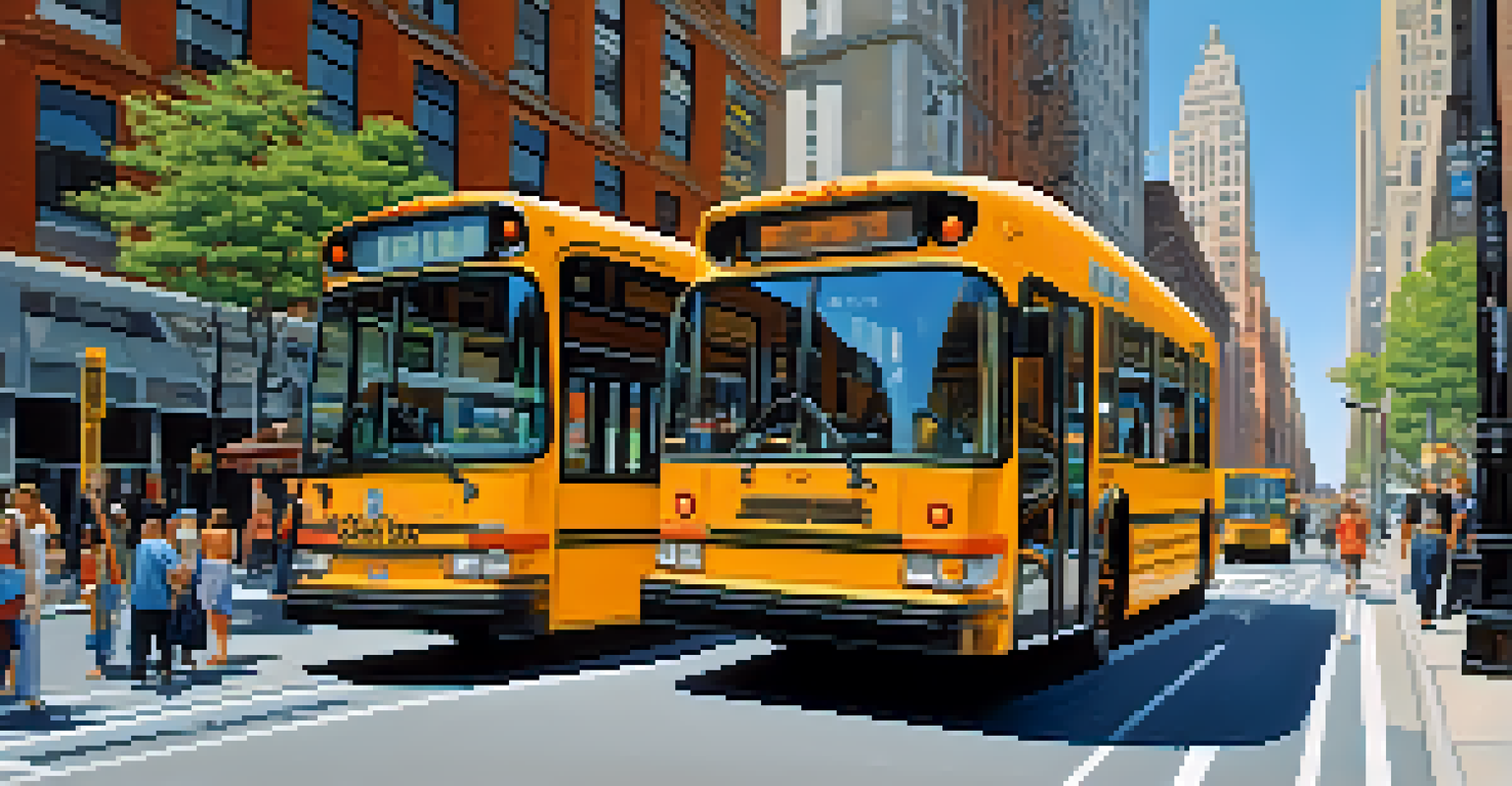Sustainable Transportation Initiatives in New York City

Introduction to Sustainable Transportation in NYC
New York City is at the forefront of sustainable transportation initiatives, reflecting a growing global commitment to eco-friendly practices. With its dense population and extensive public transit system, the city faces unique challenges and opportunities in reducing carbon emissions. Sustainable transportation aims to improve access while minimizing environmental impact, making it vital for urban development.
Sustainable transportation is not just about reducing carbon emissions; it's about improving the quality of life for everyone in our cities.
In recent years, NYC has introduced various programs designed to promote greener commuting options. These range from expanding bike lanes to enhancing public transit services, all while encouraging a shift away from single-occupancy vehicles. The overarching goal is to create a cleaner, more efficient transportation landscape for everyone.
By prioritizing sustainability, New York City not only aims to combat climate change but also strives to enhance the quality of life for its residents. This involves reducing traffic congestion, lowering air pollution, and promoting healthier travel options. Let’s dive into the specific initiatives that are propelling NYC towards a more sustainable future.
Expansion of Bicycle Infrastructure
One of the most visible changes in NYC's transportation landscape is the expansion of bicycle infrastructure. The city has invested heavily in creating dedicated bike lanes, making cycling a safer and more appealing option for commuters. This shift not only reduces reliance on cars but also promotes a healthier lifestyle for residents.

Bike-sharing programs, such as Citi Bike, have further encouraged cycling as a primary mode of transportation. These programs provide an easy and affordable way for New Yorkers to access bicycles for short trips around the city. With more bike stations popping up across neighborhoods, cycling is becoming an integral part of the urban commute.
NYC Expands Bicycle Infrastructure
The city is enhancing its bike lanes and bike-sharing programs to promote cycling as a safer and healthier commuting option.
Moreover, the city has launched educational campaigns to promote cycling safety and awareness. By encouraging residents to choose bikes over cars, NYC is making strides toward reducing traffic congestion and lowering carbon emissions. This initiative showcases how simple changes can make a significant impact on urban transportation.
Enhancing Public Transit Options
New York City’s public transit system is one of the largest in the world, and improving its efficiency is key to sustainable transportation. Recent investments have focused on modernizing subway stations, reducing wait times, and expanding service coverage. These enhancements aim to attract more riders by making public transit a more convenient option.
The future of transportation is not just about moving people; it's about creating a more sustainable and livable environment.
Additionally, initiatives like the introduction of electric buses highlight the city’s commitment to reducing emissions. These buses offer a cleaner alternative to traditional diesel models, paving the way for a greener public transit fleet. As more electric buses hit the streets, New Yorkers can enjoy a quieter, more eco-friendly ride.
Furthermore, NYC is exploring innovative solutions such as bus rapid transit (BRT) systems. BRT can significantly reduce travel times and improve reliability, making it a popular choice for commuters. By continually upgrading and expanding public transit options, New York City is striving to meet the transportation needs of its diverse population sustainably.
Car-Free Zones and Pedestrian-Friendly Streets
To promote walking and cycling, New York City has established car-free zones in various neighborhoods. These areas prioritize pedestrians, creating a more enjoyable and safer environment for those on foot or on bikes. By reducing vehicle traffic in these zones, the city fosters a sense of community and encourages local businesses to thrive.
Times Square is a prime example of a successful car-free initiative. Once a congested thoroughfare, the area has transformed into a vibrant pedestrian plaza, complete with seating and public art. This change not only enhances the experience for visitors but also significantly reduces air pollution in a high-traffic area.
Improvement of Public Transit Options
Investments in modernizing subway stations and introducing electric buses aim to make public transit more efficient and environmentally friendly.
These pedestrian-friendly initiatives are part of a broader vision to reclaim urban spaces for people rather than vehicles. By investing in walkable areas, NYC is not only improving public health but also reinforcing its commitment to sustainable urban living. Car-free zones exemplify how urban planning can support sustainable transportation goals.
Innovative Ridesharing and Mobility Solutions
Ridesharing services have revolutionized urban transportation, and NYC is embracing this trend with a sustainable twist. Companies are increasingly offering electric or hybrid vehicles to reduce their carbon footprint, aligning with the city’s sustainability goals. This move encourages users to opt for greener options when they need a lift.
Additionally, NYC is exploring partnerships with ridesharing companies to promote shared rides. By incentivizing shared rides, the city can decrease the number of vehicles on the road, leading to less traffic congestion and lower emissions. This approach not only benefits the environment but also makes ridesharing more economical for users.
Moreover, the growth of micro-mobility options, such as electric scooters and e-bikes, complements traditional ridesharing. These alternatives provide flexible and efficient ways to navigate the city, especially for short trips. By integrating various mobility solutions, NYC is paving the way for a versatile and sustainable transportation network.
Promoting Sustainable Freight and Delivery Services
As e-commerce continues to rise, New York City is addressing the environmental impact of freight and delivery services. The city is encouraging the use of electric delivery vehicles and developing designated loading zones to streamline deliveries. This initiative aims to reduce congestion and pollution caused by traditional delivery trucks.
Furthermore, NYC is exploring innovative solutions like cargo bikes for last-mile deliveries. These eco-friendly options can maneuver through crowded streets more efficiently, reducing the need for larger vehicles. By promoting alternatives to conventional freight methods, the city is working towards a greener logistics landscape.
Community Engagement Drives Change
Active involvement of residents in sustainable transportation initiatives fosters a culture of eco-conscious commuting practices across the city.
Collaborations with businesses and logistics companies play a crucial role in this initiative. By offering incentives for sustainability practices, NYC can foster a culture of eco-conscious delivery services. This proactive approach not only supports local businesses but also contributes to the city’s overall sustainability goals.
Community Engagement and Education Programs
Community engagement is vital in promoting sustainable transportation initiatives in NYC. The city actively involves residents in discussions and decision-making processes regarding transportation policies. By fostering a sense of ownership, locals are more likely to embrace sustainable practices within their communities.
Educational programs play a significant role in raising awareness about the benefits of sustainable transportation. Workshops, informational sessions, and outreach campaigns help residents understand the environmental impact of their commuting choices. This knowledge empowers individuals to make informed decisions that align with sustainability goals.

Additionally, NYC encourages community-led initiatives, such as car-free days and cycling events, to inspire participation. These events not only promote sustainable transportation but also strengthen community bonds. Through engagement and education, NYC is cultivating a culture of sustainability that extends beyond transportation.
Looking Ahead: The Future of Sustainable Transportation
The future of sustainable transportation in New York City looks promising, with ongoing initiatives aimed at reducing emissions and promoting healthy commuting. As technology continues to evolve, NYC is exploring smart transit solutions, such as integrated apps that provide real-time information on public transport and alternative routes. This innovation will enhance commuter experiences and encourage sustainable choices.
Moreover, the city is committed to achieving ambitious climate goals, including a significant reduction in greenhouse gas emissions by 2030. By investing in renewable energy for public transit and expanding electric vehicle infrastructure, NYC is setting a strong example for urban centers worldwide. These efforts demonstrate a long-term vision for a sustainable urban ecosystem.
In conclusion, NYC’s commitment to sustainable transportation initiatives is shaping a cleaner, more accessible city for all. Through collaboration, innovation, and community engagement, the city is paving the way for a future where sustainable transport is not just an option but the norm. As these initiatives continue to evolve, New Yorkers can look forward to a greener, more connected metropolis.